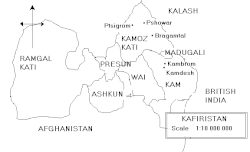
Back Kafiristan Catalan کافرستان CKB Kafiristan German Kafirıstan DIQ Kafiristano Esperanto Kafiristán Spanish Kafiristan Basque کافرستان Persian Kafiristan French काफ़िरिस्तान Hindi
Kafiristan
کافرستان | |
|---|---|
Historical region of Afghanistan & Pakistan | |
 The Kafiristan region, located in the southern range of Hindu Kush | |
 Map showing present-day Nuristan Province of Afghanistan | |
| Country | |

Kāfiristān, or Kāfirstān (Pashto: کاپیرستان; Persian: کافرستان; lit. 'Land of Infidels'), is a historical region that covered present-day Nuristan Province in Afghanistan and its surroundings. This historic region lies on, and mainly comprises, the basins of the rivers Alingar, Pech (Kamah), Landai Sin river and Kunar, and the intervening mountain ranges. It is bounded by the main range of the Hindu Kush on the north, Pakistan's Chitral District to the east, the Kunar Valley in the south and the Alishang River in the west.
Kafiristan took its name from the enduring kafir (non-Muslim) Nuristani inhabitants who once followed a distinct form of ancient Hinduism mixed with locally developed accretions; they were thus known to the surrounding predominantly Sunni Muslim population as Kafirs, meaning "disbelievers" or "infidels".[1] They are closely related to the Kalash people, an independent people with a distinctive culture, language and religion.
The area extending from modern Nooristan to Kashmir was known as "Peristan", a vast area containing a host of "Kafir" cultures and Indo-European languages that became Islamized over a long period of time, which eventually led them to become Muslim on the orders of Emir Abdur Rahman Khan who conquered the territory in 1895–96. The region was earlier surrounded by Buddhist states that temporarily brought literacy and state rule to the mountains; the decline of Buddhism heavily isolated the region. It was surrounded by Muslim states in the 16th century.[2]
- ^ Richard F. Strand (31 December 2005). "Richard Strand's Nuristân Site: Peoples and Languages of Nuristan". nuristan.info.
- ^ Alberto M. Cacopardo (2016). "Fence of Peristan – The Islamization of the "Kafirs" and Their Domestication". Archivio per l'Antropologia e la Etnologia. Società Italiana di Antropologia e Etnologia: 69, 77.